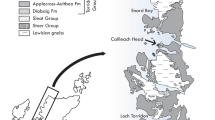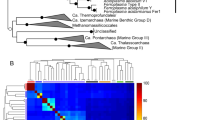Abstract
In situ phosphatization1 and reductive cell division2 have recently been discovered within the vacuolate sulphur-oxidizing bacteria. Here we show that certain Neoproterozoic Doushantuo Formation (about 600 million years bp) microfossils, including structures previously interpreted as the oldest known metazoan eggs and embryos3,4,5,6,7,8,9,10, can be interpreted as giant vacuolate sulphur bacteria. Sulphur bacteria of the genus Thiomargarita have sizes and morphologies similar to those of many Doushantuo microfossils, including symmetrical cell clusters that result from multiple stages of reductive division in three planes. We also propose that Doushantuo phosphorite precipitation was mediated by these bacteria, as shown in modern Thiomargarita-associated phosphogenic sites, thus providing the taphonomic conditions that preserved other fossils known from the Doushantuo Formation.
This is a preview of subscription content, access via your institution
Access options
Subscribe to this journal
Receive 51 print issues and online access
$199.00 per year
only $3.90 per issue
Buy this article
- Purchase on Springer Link
- Instant access to full article PDF
Prices may be subject to local taxes which are calculated during checkout



Similar content being viewed by others
References
Schulz, H. N. & Schulz, H. D. Large sulfur bacteria and the formation of phosphorite. Science 307, 416–418 (2005)
Kalanetra, K. M., Joye, S. B., Sunseri, N. R. & Nelson, D. C. Novel vacuolate sulfur bacteria from the Gulf of Mexico reproduce by reductive division in three dimensions. Environ. Microbiol. 7, 1451–1460 (2005)
Xiao, S., Yuan, X. & Knoll, A. H. Eumetazoan fossils in terminal Proterozoic phosphorites?. Proc. Natl Acad. Sci. USA 97, 13684–13689 (2000)
Li, C., Chen, J. & Hua, T. E. Precambrian sponges with cellular structures. Science 279, 879–882 (1998)
Chen, J.-Y. The Dawn of Animal World (Jiangsu Science & Technology, Nanjing, 2004)
Chen, J.-Y. et al. Phosphatized polar lobe-forming embryos from the Precambrian of southwest China. Science 312, 1644–1646 (2006)
Chen, J.-Y. et al. Precambrian animal life: probable developmental and adult cnidarian forms from southwest China. Dev. Biol. 248, 182–196 (2002)
Chen, J.-Y. et al. Precambrian animal diversity: New evidence from high resolution phosphatized embryos. Proc. Natl Acad. Sci. USA 97, 4457–4462 (2000)
Xiao, S. & Knoll, A. H. Phosphatized animal embryos from the Neoproterozoic Doushantuo Formation at Weng’an, Guizhou, South China. J. Paleontol. 74, 767–788 (2000)
Xiao, S., Zhang, Y. & Knoll, A. H. Three-dimensional preservation of algae and animal embryos in a Neoproterozoic phosphorite. Nature 391, 553–558 (1998)
Awramik, S. M. et al. Prokaryotic and eukaryotic microfossils from a Proterozoic/Phanerozoic transition in China. Nature 315, 655–658 (1985)
Zhou, C., Brasier, M. D. & Xue, Y. Three-dimensional phosphatic preservation of giant acritarchs from the Terminal Proterozoic Doushantuo Formation in Ghizhou and Hubei Provinces, South China. Palaeontology 44, 1157–1178 (2001)
Zhang, Y., Yin, L., Xiao, S. & Knoll, A. H. Permineralized fossils from the Terminal Proterozoic Doushantuo Formation, South China. Paleontol. Soc. Mem. 50, 1–52 (1998)
Chen, J.-Y. et al. Small bilaterian fossils from 40 to 55 million years before the Cambrian. Science 305, 218–222 (2004)
Barfod, G. H. et al. New Lu-Hf and Pb-Pb age constraints on the earliest animal fossils. Earth Planet. Sci. Lett. 201, 203–212 (2002)
Xue, Y., Tang, T., Yu, C. & Zhou, C. Large spheroidal chlorophyta fossils from the Doushantuo Formation phosphoric sequence (late Sinian), central Guizhou, South China. Acta Palaeontol. Sin. 34, 688–706 (1995)
Xiao, S. Mitotic topologies and mechanics of Neoproterozoic algae and animal embryos. Paleobiology 28, 244–250 (2002)
Hagadorn, J. W. et al. Cellular and subcellular structure of Neoproterozoic animal embryos. Science 314, 291–294 (2006)
Martin, D., Briggs, D. E. G. & Parkes, R. J. Decay and mineralization of invertebrate eggs. Palaios 20, 562–572 (2005)
Raff, E. et al. Experimental taphonomy shows the feasibility of fossil embryos. Proc. Natl Acad. Sci. USA 103, 5846–5851 (2006)
Xiao, S. & Knoll, A. H. Fossil preservation in the Neoproterozoic Doushantuo phosphorite Lagerstätte, South China. Lethaia 32, 219–240 (1999)
Schulz, H. N. in The Prokaryotes: An Evolving Electronic Resource for the Microbiological Community (eds Dworkin, M. et al. ) 〈 http://141.150.157.117:8080〉 (2006)
Jørgensen, B. B. & Nelson, D. C. in Sulfur Biogeochemistry—Past and Present (eds Amend, J. P., Edwards, K. J. & Lyons, T.W.) 63–81 (Geol. Soc. Am. Spec. Pap. 379, Boulder, Colorado, 2004)
Schulz, H. N. et al. Dense populations of a giant sulfur bacterium in Namibian shelf sediments. Science 284, 493–495 (1999)
Dornbos, S. Q. et al. Precambrian animal life: Taphonomy of phosphatized metazoan embryos from southwest China. Lethaia 38, 101–109 (2005)
Xue, Y. S., Tang, T. F. & Yu, C. L. ‘Animal embryos,’ a misinterpretation of Neoproterozoic microfossils. Acta Micropaleontol. Sin. 16, 1–4 (1999)
Xiao, S. & Knoll, A. H. Embryos or algae? A reply. Acta Micropaleontol. Sin. 16, 313–323 (1999)
Costello, D. P. & Henley, C. Methods for Obtaining and Handling Marine Eggs and Embryos (Marine Biological Laboratory, Woods Hole, Massachusetts, 1971)
Goldberg, T., Poulten, S. W. & Strauss, H. Sulphur and oxygen isotope signatures of late Neoproterozoic to early Cambrian sulphate, Yangtze Platform, China: Diagenetic constraints and seawater evolution. Precambr. Res. 137, 223–241 (2005)
Bengston, S. & Budd, G. Comment on ‘Small bilaterian fossils from 40 to 55 million years before the Cambrian’. Science 306, 1291a (2004)
Acknowledgements
We thank D. Bottjer, D. Caron, A. Jones, R. Schaffner, S. Douglas, A. Thompson and D. Nelson for discussions, advice and/or assistance. This project was funded by the US National Science Foundation Graduate Research Fellowship, Earth Sciences, and Life in Extreme Environments programs, as well as the NASA Exobiology Program. Submersible operations in the Gulf of Mexico were supported by the US Department of Energy and the National Oceanic and Atmospheric Administration’s National Undersea Research Program.
Author information
Authors and Affiliations
Corresponding author
Ethics declarations
Competing interests
Reprints and permissions information is available at www.nature.com/reprints. The authors declare no competing financial interests.
Supplementary information
Supplementary Information
This file contains Supplementary Notes and Supplementary Figures 1-8 with legends. (PDF 1363 kb)
Rights and permissions
About this article
Cite this article
Bailey, J., Joye, S., Kalanetra, K. et al. Evidence of giant sulphur bacteria in Neoproterozoic phosphorites. Nature 445, 198–201 (2007). https://doi.org/10.1038/nature05457
Received:
Accepted:
Published:
Issue Date:
DOI: https://doi.org/10.1038/nature05457
This article is cited by
-
Ultrastructure and in-situ chemical characterization of intracellular granules of embryo-like fossils from the early Ediacaran Weng’an biota
PalZ (2021)
-
Ediacaran Doushantuo-type biota discovered in Laurentia
Communications Biology (2020)
-
Identification of bacterial fossils in marine source rocks in South China
Acta Geochimica (2018)
-
Microbial Diversity in Phosphate Rock and Phosphogypsum
Waste and Biomass Valorization (2017)
-
The Jinxian Biota revisited: taphonomy and body plan of the Neoproterozoic discoid fossils from the southern Liaodong Peninsula, North China
PalZ (2016)
Comments
By submitting a comment you agree to abide by our Terms and Community Guidelines. If you find something abusive or that does not comply with our terms or guidelines please flag it as inappropriate.



